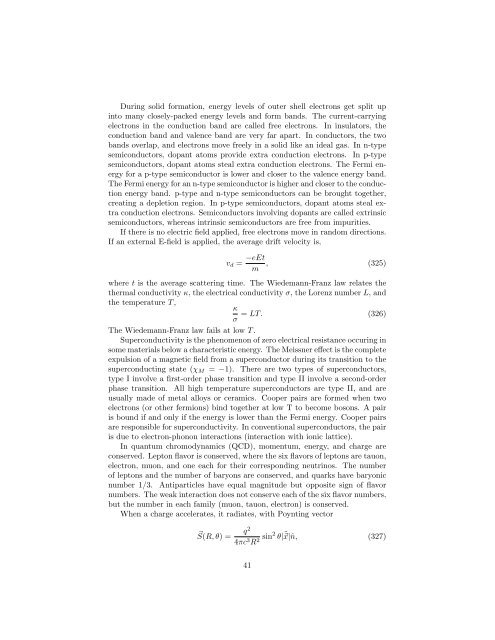Notes for the Physics GRE - Harvard University Department of Physics
Notes for the Physics GRE - Harvard University Department of Physics
Notes for the Physics GRE - Harvard University Department of Physics
You also want an ePaper? Increase the reach of your titles
YUMPU automatically turns print PDFs into web optimized ePapers that Google loves.
During solid <strong>for</strong>mation, energy levels <strong>of</strong> outer shell electrons get split upinto many closely-packed energy levels and <strong>for</strong>m bands. The current-carryingelectrons in <strong>the</strong> conduction band are called free electrons. In insulators, <strong>the</strong>conduction band and valence band are very far apart. In conductors, <strong>the</strong> twobands overlap, and electrons move freely in a solid like an ideal gas. In n-typesemiconductors, dopant atoms provide extra conduction electrons. In p-typesemiconductors, dopant atoms steal extra conduction electrons. The Fermi energy<strong>for</strong> a p-type semiconductor is lower and closer to <strong>the</strong> valence energy band.The Fermi energy <strong>for</strong> an n-type semiconductor is higher and closer to <strong>the</strong> conductionenergy band. p-type and n-type semiconductors can be brought toge<strong>the</strong>r,creating a depletion region. In p-type semiconductors, dopant atoms steal extraconduction electrons. Semiconductors involving dopants are called extrinsicsemiconductors, whereas intrinsic semiconductors are free from impurities.If <strong>the</strong>re is no electric field applied, free electrons move in random directions.If an external E-field is applied, <strong>the</strong> average drift velocity is,v d = −eEtm , (325)where t is <strong>the</strong> average scattering time. The Wiedemann-Franz law relates <strong>the</strong><strong>the</strong>rmal conductivity κ, <strong>the</strong> electrical conductivity σ, <strong>the</strong> Lorenz number L, and<strong>the</strong> temperature T ,κ= LT. (326)σThe Wiedemann-Franz law fails at low T .Superconductivity is <strong>the</strong> phenomenon <strong>of</strong> zero electrical resistance occuring insome materials below a characteristic energy. The Meissner effect is <strong>the</strong> completeexpulsion <strong>of</strong> a magnetic field from a superconductor during its transition to <strong>the</strong>superconducting state (χ M = −1). There are two types <strong>of</strong> superconductors,type I involve a first-order phase transition and type II involve a second-orderphase transition. All high temperature superconductors are type II, and areusually made <strong>of</strong> metal alloys or ceramics. Cooper pairs are <strong>for</strong>med when twoelectrons (or o<strong>the</strong>r fermions) bind toge<strong>the</strong>r at low T to become bosons. A pairis bound if and only if <strong>the</strong> energy is lower than <strong>the</strong> Fermi energy. Cooper pairsare responsible <strong>for</strong> superconductivity. In conventional superconductors, <strong>the</strong> pairis due to electron-phonon interactions (interaction with ionic lattice).In quantum chromodynamics (QCD), momentum, energy, and charge areconserved. Lepton flavor is conserved, where <strong>the</strong> six flavors <strong>of</strong> leptons are tauon,electron, muon, and one each <strong>for</strong> <strong>the</strong>ir corresponding neutrinos. The number<strong>of</strong> leptons and <strong>the</strong> number <strong>of</strong> baryons are conserved, and quarks have baryonicnumber 1/3. Antiparticles have equal magnitude but opposite sign <strong>of</strong> flavornumbers. The weak interaction does not conserve each <strong>of</strong> <strong>the</strong> six flavor numbers,but <strong>the</strong> number in each family (muon, tauon, electron) is conserved.When a charge accelerates, it radiates, with Poynting vector⃗S(R, θ) =q24πc 3 R 2 sin2 θ|¨⃗x|ˆn, (327)41
















